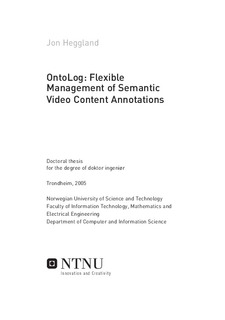| dc.description.abstract | To encode, query and present the semantic content of digital video precisely and flexibly is very useful for many kinds of knowledge work: system analysis and evaluation, documentation and education, to name a few. However, that kind of video management is not a trivial matter. The traditional stratified annotation model has quite poor facilities for specifying the meaning – the structure and relationships – of the strata. Because of this, it may also be troublesome to present the annotations to the users in a clear and flexible manner.
This thesis presents OntoLog, a system for managing the semantic content of video. It extends the stratified annotation model by defining the strata as objects and classes in ontologies, thereby making their semantic meaning more explicit and relating them to each other in a semantic network. The same ontologies are also used to define properties and objects for describing both the strata, individual video intervals and entire videos. This constitutes a very customisable, expressive and precise description model, without sacrificing simplicity and conceptual integrity.
Arranging the annotation strata in a near-hierarchical network with specified semantics (classes, subclasses and instances) also enables reasoning about the annotations during query and browsing. In particular, it enables visual aggregation of traditional timeline-based strata graphics. Using this to create compact content visualisations, the OntoLog system is able to present tens of videos on screen at the same time, thus providing inter-video browsing. By judiciously disaggregating selected parts of the strata hierarchy, users can focus on relevant strata at their preferred level of detail – overview-and-zoom functionality for semantic annotations, in other words.
The OntoLog system has been implemented in the form of six Java applications and web services – together covering annotation editing, browsing, analysis, search, query and presentation with various approaches – built on top of an RDF database founded on SQL. The system has been tested under realistic conditions in several real-world projects, with good results. A novel information gathering interface for OntoLog data, Savanta, has been created. This is based on an iterative interaction paradigm featuring inter-video browsing, filtering, navigation and context-sensitive temporal analysis of the annotations. In a comparative usability evaluation, Savanta is shown to outperform more traditional user interfaces for video search/browsing with regard to expressive power, straightforwardness and user satisfaction. | nb_NO |
